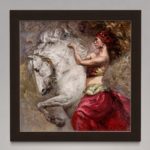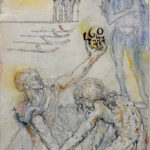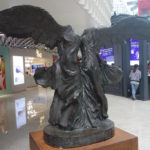By Reed V. Horth, for ROBIN RILE FINE ART
One summer in high school, I remember having to read Shakespeare’s “Hamlet” from cover to cover. While I enjoyed it immensely, the work disturbed me. Not only was it discomfiting because of its lyrical prose and nonsensical wordplay, but also because of Hamlet’s (or perhaps Shakespeare’s) preoccupation with death. As a wanna-be metal-head, I had posters of Iron Maiden and Molly Hatchet which also dealt with death and skeletons but, my innate nature geared me more toward Otis Redding, Wilson Pickett and Sam Cooke. So… the skulls were not necessarily a good fit at the time. Therefore, the image of Hamlet holding the disembodied skull of his childhood guardian stuck with me to this day.
“Alas, poor Yorick! I knew him, Horatio; a fellow of infinite jest, of most excellent fancy; he hath borne me on his back a thousand times; and now, how abhorred in my imagination it is! My gorge rises at it. Here hung those lips that I have kissed I know not how oft. Where be your gibes now?” (Shakespeare. Hamlet, V.i)

It seems that skulls have gotten a bad rap over the centuries. Even in Shakespeare they signified death and foreboding. Today, they seem to embody and remind us of the perpetual darkness we are spoon-fed during the 24 hour news cycle. However, we all have skulls which cradle our thoughts and give comfort to our brains. Sometimes they pulse with anticipation, and sometimes they ache with the pressure of a vice-like grip. Our skulls provide us with the foundation from which our outward beauty can take shape and our inward beauty can be safely guarded. Perhaps this rehabilitation of the skull’s image is a product of more optimism in our social and artistic zeitgeist.
“Webster was much possessed by death / And saw the skull beneath the skin.” ~T.S. Eliot

Artists have always been fascinated with skulls, perhaps because of their lineage to art school classes teaching anatomy, or perhaps their deep psychological impact on both mortality and creativity. In the 1880’s, with the looming disenfranchisement of workers which was predicted for the coming 20th century, Van Gogh’s “Skull of a Skeleton with Burning Cigarette” had equal parts cynicism and humor. A salve to what he and others were feeling in France during the years after the Franco-Prussian defeat and the contemporary industrial revolution. Salvador Dali’s 1951 photographic collaboration with Phillippe Halsman harked both to the spectre of nuclear war and Dali’s preoccupation with the feminine mystique. Jim Dine’s and Andy Warhol’s decade-apart skulls are as anatomical as they are metaphorical in portraying only the irony of colorful happiness amidst the somber subject and heavy years of the late 70’s and early 80’s.

How do you make the morbid curious to the masses again? Perhaps with a luxurious makeover. The familiar visage of the human skull has experienced a marked resurgence in the past few years thanks to the bad-boy of contemporary shock-art, Damien Hirst. His diamond-studded “For the Love of God” (above) reclaimed the skull from the annals of heavy metal-band history and restored it to respectability once again. Hirst created a platinum cast of a human skull thought to have been an Englishman from between 1720 and 1810. He then covered the cast with 8,601 flawless diamonds, including a pear-shaped pink diamond, and slapped a price-tag of £50 million on it at its debut in 2007. What was created is precisely what Hirst was seeking, kinetic energy around his Art. An unintended consequence was that skulls became interesting again.
Our own A. Nicolas’ acrylic skulls (which are encased in yet more acrylic to give them a clinical-aura of a mortuary or alchemical laboratory) provide a contemporary statement which is amusing, jarring and thought-provoking. “Functions of the skull include protection of the brain, fixing the distance between the eyes to allow stereoscopic vision, and fixing the position of the ears to help the brain use auditory cues to judge direction and distance of sounds. In some animals, the skull also has a defensive function (e.g. horned ungulates); the frontal bone is where horns are mounted.” [op. cit. Wikipedia, Skull] In certain instances, Nicolas’ own skulls utilize other defensive mechanisms to ward off threats, including the halo of plastic Army soldiers in his enigmatic “George” (below) and “Houssama”.

These skull-functions also remind us of how our senses are tied to our perceptions of Art in general. Our skull embraces our brains which interpret the sights, sounds, feel, smells and even tastes we experience when immersing ourselves in Art. Imagine a world where our Art did not encompass the broad gamut of senses. A nice glass of wine in a gallery-setting. Candles wafting vanilla throughout the room. Beautiful people, art and locale. The cold touch of sculpture beneath our careful hands. Our senses determine our feelings towards our Art. Thusly, our skulls are an invaluable and essential part of our bodies, likes and… consequently, our Art.
So…. Have you hugged your skull lately?
Other Skulls and Links to be aware of:
Skull sculpture outside the Venice Modern Art Museum – Venice, Italy. Damien Hirst used diamonds, but Subodh Gupta’s one-ton skull is a more appropriate sculpture for our eco-aware credit crunch times. Very Hungry God is made from aluminum pots and pans, and has been exhibited in a Paris church, paraded on a gondola in Venice, and now appears in Moscow’s largest ever contemporary art show – hosted by Daria Zhukova, Roman Abramovich’s girlfriend.
Gupta said of his work “I made the work in response to the stories I read in the news about how soup kitchens in Paris were serving food with pork so that Muslims would not eat it. It was a strange and twisted form of charity that did not continue for long but raised conflicting ideas of giving and the way we have become now.” [http://entertainment.timesonline.co.uk/tol/arts_and_entertainment/visual_arts/article5968992.ece]
“Happy Head No 7,” by Damien Hirst, gloss household paint on resin skull and wooden base, 9 1/2 by 9 by 9 1/2 inches, 2007 [From: [http://www.thecityreview.com/f08ppcon1.html]
Jim Skull is an artist working out of Paris whose work focuses on the skull form utilizing a variety of coiling methods. More examples of his work can be seen at his website: [www.jim-skullgallery.com]
Pac Man’s Skull Exposed
06/05/2007 | by Vanessa Ruiz | Who knew that a circle with a giant mouth and tiny eyes could have such interesting anatomy beneath the surface. Pac-man’s skull was carefully crafted by artist Le Gentil Garcon after studying the skulls of human and predatory animals. He even collaborated with paleontologist Francois Escuille to make the most accurate representation right down to the tiny sacrum on his back-end.
The skull is 65cm in diameter and made of resin. [http://streetanatomy.com/2007/06/05/pac-mans-skull-exposed/]









